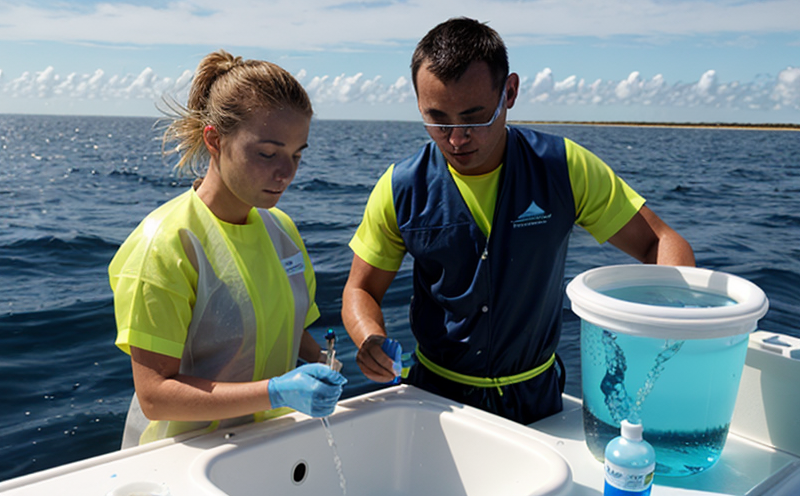ISO 7890-3 Nitrate Test in Seawater
The ISO 7890 series of standards provides a robust framework for nitrate testing across various aqueous environments, including seawater. This service focuses on the third part of the standard, which specifically addresses the determination of nitrate nitrogen (NO3-) in marine waters. The ISO 7890-3 protocol is designed to ensure accuracy and consistency in measuring nitrate levels, which are critical for understanding the health of aquatic ecosystems.
The nitrate concentration in seawater plays a significant role in marine ecology. High concentrations can indicate pollution from agricultural runoff or industrial discharge, while low concentrations might suggest an imbalanced ecosystem. Accurate measurement is essential for environmental monitoring and compliance with international regulations such as those outlined by the UNEP and OECD.
The testing process involves several key steps. First, seawater samples are collected using standardized protocols to ensure representativeness. These samples must then undergo rigorous preprocessing, which includes filtration through 0.45 μm pore-size membranes to remove particulate matter that could interfere with the analysis.
Once filtered, the samples are analyzed using a spectrophotometric method based on ISO 7890-3 guidelines. This involves adding reagents and incubating the sample for a specific duration before measuring absorbance at a wavelength of approximately 220 nm. The absorbance is then converted to nitrate concentration using calibration curves derived from known standards.
The accuracy and precision of this method are ensured through strict quality control measures, including inter-laboratory comparisons and regular instrument calibrations. Compliance with ISO standards guarantees that results can be trusted by regulatory bodies and stakeholders worldwide. This service ensures that clients receive reliable data that aligns with international best practices.
For clients interested in understanding the broader implications of nitrate testing, we offer comprehensive reports detailing not only the quantitative results but also their ecological significance. These reports help in identifying sources of contamination and guiding remediation efforts if necessary.
Industry Applications
| Application Area | Description |
|---|---|
| Oceanography | Monitoring nitrate levels to assess the impact of climate change on marine ecosystems. |
| Environmental Monitoring | Detecting pollution from agricultural and industrial sources in coastal waters. |
| Marine Biology Research | Understanding nutrient cycling and its effects on marine life. |
| Regulatory Compliance | Ensuring compliance with environmental regulations related to seawater quality. |
Environmental and Sustainability Contributions
- Reduces contamination risks by identifying sources of nitrate pollution in marine environments.
- Promotes sustainable practices by supporting informed decision-making for environmental management.
- Aids in the conservation of biodiversity through accurate ecological assessments.
- Supports global efforts to protect marine ecosystems and combat climate change.
The ISO 7890-3 nitrate test plays a crucial role in safeguarding our oceans by providing reliable data that informs policy decisions. By ensuring compliance with international standards, this service contributes significantly to sustainable environmental practices.
Use Cases and Application Examples
- Sampling Sites: Coastal regions undergoing development projects where potential runoff from construction sites needs monitoring.
- Regulatory Compliance: Governments conducting regular checks to ensure compliance with nitrate concentration limits set by international agreements.
- Research Institutions: Universities studying the effects of climate change on marine ecosystems, focusing on nutrient cycles and their impacts.
The ISO 7890-3 nitrate test is a cornerstone in environmental monitoring efforts. It helps in maintaining water quality standards and supports sustainable development practices globally.





